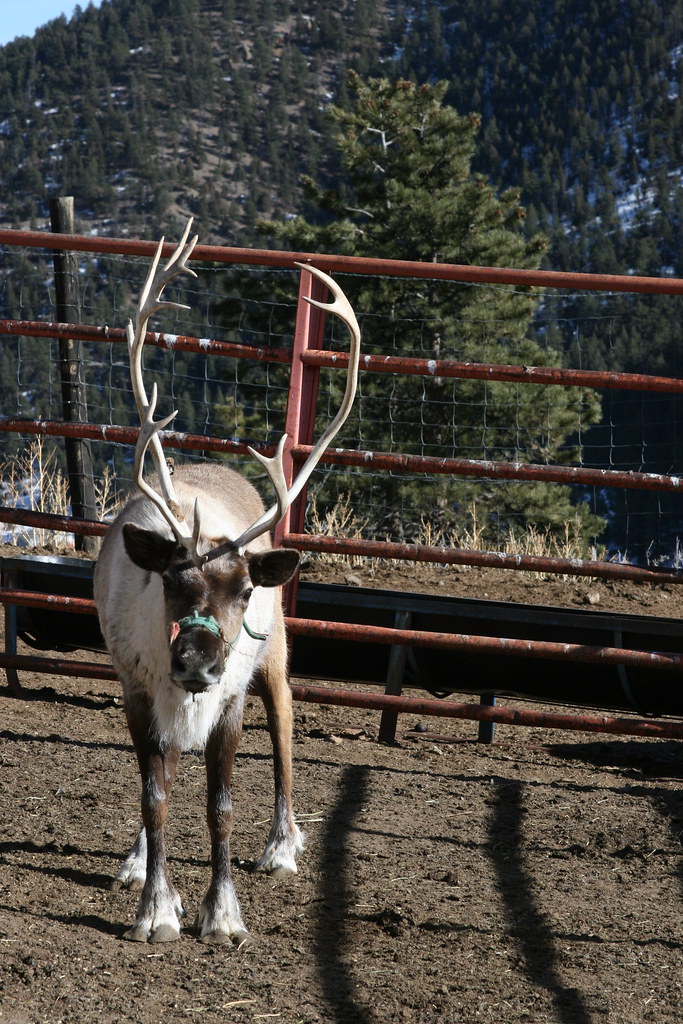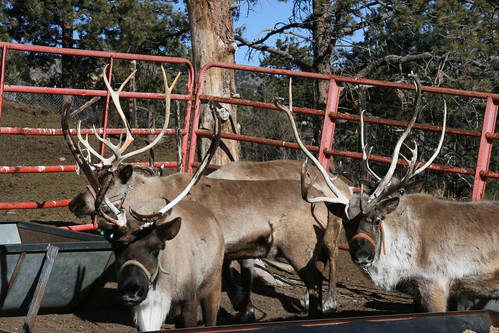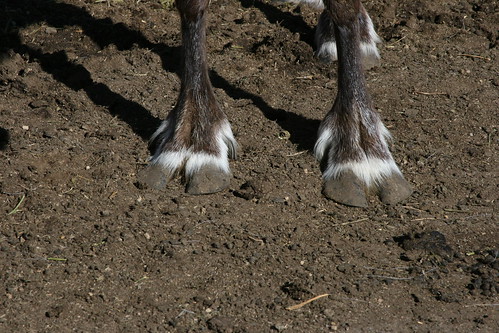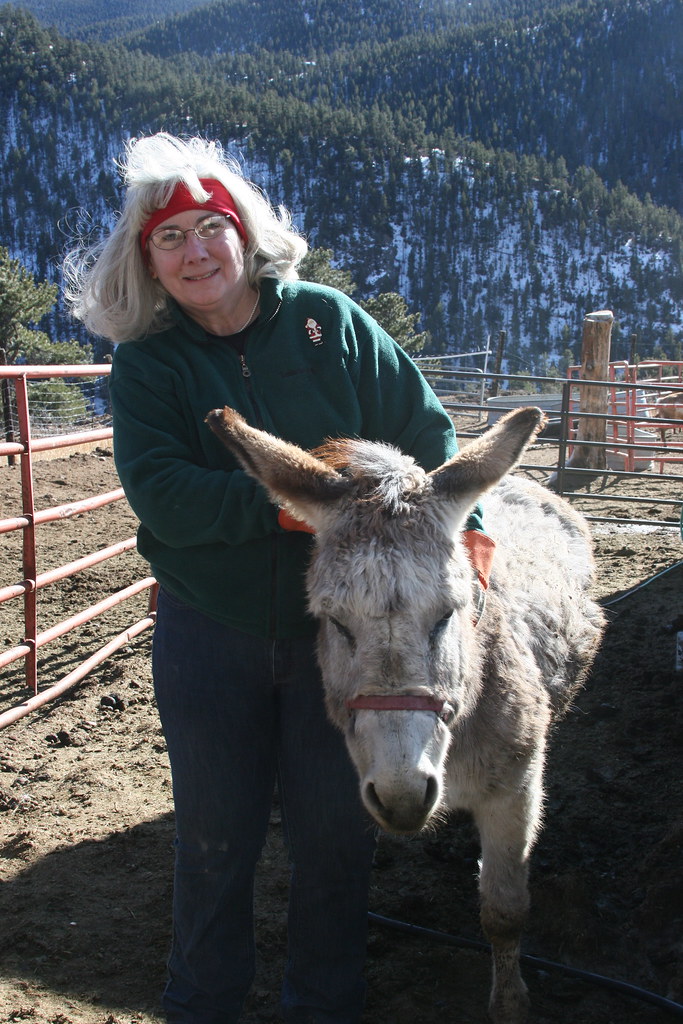 (This is a cross-post from BlogHer. I seem to be brimming with holiday joy this year and I've decided not to fight it.)
(This is a cross-post from BlogHer. I seem to be brimming with holiday joy this year and I've decided not to fight it.) In trying to wrap my head around Santa's looming global task, my mind wandered to his flying fleet. Just who were these magical creatures of the season? In an effort to learn about the elegant reindeer, I soon found myself (along with two pals) at the Laughing Valley Ranch in Idaho Springs, Colorado, face-to-antlers with Mrs. Claus (Carol Lee) and a real live reindeer herd.
Lo and behold, I had no idea that the 85-acre ranch is also a training ground for Santa's elite fleet. (That's right, THE Santa - not the guys at the mall.) Since these animals only live 15-20 years, new recruits are always being sought for the most coveted job in reindeer-dom.
The name 'reindeer' is actually the Northern European term for 'caribou', in the same way that that 'burro' is the Spanish word for 'donkey.' (Reindeer are commonly known as domesticated caribou.) There are at least seven sub-species of caribou but Santa favors the Pearyi Caribou, as they are smallest, just three or four feet at the shoulders. Of course, these reindeer are native to the North Pole.
Turns out, only 1 in 3,000 Pearyi reindeer have what it takes to be part of Santa's fleet. Each animal must be in peak physical condition to perform the herculean task of bringing Christmas joy to the world's children. Once trained, these unique animals will have to fly 75 million miles over a 48-hour period (December 24-25) at 650 miles per second. (Many times the speed of sound but not quite the speed of light, meaning they arrive long before Santa's "Ho, ho, ho!"'s do.)
Santa's fleet is usually made up of steers (castrated males) or cows (females) but never bulls (intact males.) This is because they are usually too grumpy and weak from the autumn rut - the stressful mating season. During the rut, bulls will go without eating for up to 45 days and often lose their antlers just before Christmas. (Antlers are necessary for flight, providing stabilization much like the wings and tail of an airplane.) The final reason: Bulls don't live as long, just seven to 10 years.
Carol (born on Christmas Day) was kind enough to give us a tour of the ranch, while her husband, Bill (Father Christmas, Chief Wrangler and the storyteller known as 'Red Tail the Mountain Man') was out with two reindeer at some scheduled holiday appearance. Bill started with two reindeer about 25 years ago and the herd has grown. When I'd asked Bill on the phone how many reindeer he had, he responded firmly, "Nine, of course!"
 I discovered that to own and exhibit reindeer in the United States, you have to be licensed, as they are considered 'exotic animals.' This license is dispensed by the Department of Agriculture, out of its APHIS department - which handles the exhibition of exotic animals. It also helps to belong to the Reindeer Owners and Breeders Association (ROBA) which offers the tagline: "Reindeer .... Not just for Santa anymore!"
I discovered that to own and exhibit reindeer in the United States, you have to be licensed, as they are considered 'exotic animals.' This license is dispensed by the Department of Agriculture, out of its APHIS department - which handles the exhibition of exotic animals. It also helps to belong to the Reindeer Owners and Breeders Association (ROBA) which offers the tagline: "Reindeer .... Not just for Santa anymore!"  Like their cousins, moose and elk, reindeer lose their antlers each winter, and grow them suckers right back in the new year. Carol says they grow up to one to two inches a day. A giant brush from a street cleaning truck stands end up on their pen - ideal for scraping their annual velvet off their antlers. "You can almost see them growing," said Carol. "You touch them and can feel them pulsating."
Like their cousins, moose and elk, reindeer lose their antlers each winter, and grow them suckers right back in the new year. Carol says they grow up to one to two inches a day. A giant brush from a street cleaning truck stands end up on their pen - ideal for scraping their annual velvet off their antlers. "You can almost see them growing," said Carol. "You touch them and can feel them pulsating." Originally, reindeer were found in Scandinavia, Eastern Europe, Russia, Mongolia, and northern China. In North America, they were spotted in Canada, Alaska, and from Washington to Maine. In the 19th century, reindeer were still wild in southern Idaho. Although still wild in the Arctic and Subarctic, reindeer can be found on various ranches throughout the Northern U.S. (There are three in Colorado alone.)
Seeing the reindeer in person is like seeing anything iconic image in real life, not unlike the first time I laid eyes on the Sydney Opera House. Yup. There they were - big antlers, funky beards, barrel bellies and those very, very odd split hooves. They are wide 'dew claws' that act like snowshoes or fins in the water. (Turns out, reindeer are not just skilled in the air, but in the water as well.) Moving around, they 'click, click, click' with their hooves and antlers. And while they all have individual personalities, both Carol and Bill agree: "They're like Siamese cats with antlers." Kind of skittish, weird and yes, cute.
 Being outside in chilly weather is key to the animal. "If you bring them indoors, they start to pant and get very uncomfortable," said Carol. In addition to special nasal passages that help heat the cold air before it enters their lungs, the reindeer coat has two layers of fur - a dense woolly undercoat and longer-haired overcoat consisting of hollow, air-filled hairs. In short, the perfect winter animal.
Being outside in chilly weather is key to the animal. "If you bring them indoors, they start to pant and get very uncomfortable," said Carol. In addition to special nasal passages that help heat the cold air before it enters their lungs, the reindeer coat has two layers of fur - a dense woolly undercoat and longer-haired overcoat consisting of hollow, air-filled hairs. In short, the perfect winter animal. I should mention that Laughing Valley Ranch has more than just reindeer roaming around. We met eight Scottish Highlanders (hippie cows), 15 goats, nine Shetland sheep, two 'generic' sheep (Murphy & Chuck), bunch o'chickens (they sell eggs), dogs (three inside, three outside and 20 foster pups, including three wolf-hybrids), 12 llamas (including Fozzie, who loves to kiss the girls), 30 donkeys, mules, horses and one alpaca named PacMan. Everybody gets fed twice a day except the cows and the reindeer. Why? Because both animals have four stomachs.
My favorite? It has to be Heather, the pygmy goat with the broken leg in a cast. She lives in the gated playground in the front yard and is snugly by nature. She is one of Carol's 'bottle babies', animals that have had to be brought in to the house to be bottle fed. Carol is clearly the mother of all these creatures and it is she who names all the animals.
 Although I shouldn't forget Primrose, the world's first donkey to be fitted with a prosthetic. (She's a big star on PBS.) "She's a real sweetheart," said Carol.
Although I shouldn't forget Primrose, the world's first donkey to be fitted with a prosthetic. (She's a big star on PBS.) "She's a real sweetheart," said Carol. Throughout the year, the Lees provide animals for petting zoos (two of each animals) but for six weeks out of the year, Operation Reindeer goes into high gear. That's when the couple's five horse trailers get put into action as they deliver animals for nativity scenes, children's zoos and any Santa-scene where reindeer are required. "From the day after Thanksgiving to Christmas Eve, we are in demand," said Carol. It's quite a task to even imagine and each reindeer needs their own 'elf' to keep all the pointy madness under control.
People like Carol and Bill put in a lot of hours to help keep the Christmas magic alive. It makes me feel grateful for the whole shebang, which is the whole point of the season, right? My take-away from my visit to Laughing Valley Ranch is this: Make your best effort - no matter your spiritual beliefs or non-beliefs - to keep your eyes on the skies late tomorrow evening. You might just see some funny-looking hooves float above head...
Ho-Ho-Ho!
(More photos from the day's visit here.)
3 comments:
Smashing!!!! I also learned recently from a bunch of elderly Europeans that clearly know what they are talking about.... that Santa's Red and White outfit is inspired by the Amanita Muscaria Mushroom, which is the famous Red shroom with white spots. These sage historians (mycologists) tell me that the Caribou eat said mushrooms every year and then bound about wildly as though they wanted to take flight! So I guess Santa ate some too and they all made a divine plan to bring us treats every year to help us waste time and cure the munchies! YAY!
Come to think of it, it makes perfect sense that mushrooms would figure into the whole Santa scenario.
Learned so much about reindeer. Thanks for this. Could job of integrating the magical with the informative.
Post a Comment